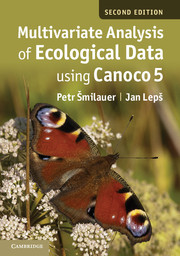Book contents
- Frontmatter
- Contents
- Preface
- 1 Introduction and data types
- 2 Using Canoco 5
- 3 Experimental design
- 4 Basics of gradient analysis
- 5 Permutation tests and variation partitioning
- 6 Similarity measures and distance-based methods
- 7 Classification methods
- 8 Regression methods
- 9 Interpreting community composition with functional traits
- 10 Advanced use of ordination
- 11 Visualising multivariate data
- 12 Case study 1: Variation in forest bird assemblages
- 13 Case study 2: Search for community composition patterns and their environmental correlates: vegetation of spring meadows
- 14 Case study 3: Separating the effects of explanatory variables
- 15 Case study 4: Evaluation of experiments in randomised complete blocks
- 16 Case study 5: Analysis of repeated observations of species composition from a factorial experiment
- 17 Case study 6: Hierarchical analysis of crayfish community variation
- 18 Case study 7: Analysis of taxonomic data with discriminant analysis and distance-based ordination
- 19 Case study 8: Separating effects of space and environment on oribatid community with PCNM
- 20 Case study 9: Performing linear regression with redundancy analysis
- Appendix A Glossary
- Appendix B Sample data sets and projects
- Appendix C Access to Canoco and overview of other software
- Appendix D Working with R
- References
- Index to useful tasks in Canoco 5
- Subject index
4 - Basics of gradient analysis
Published online by Cambridge University Press: 05 May 2014
- Frontmatter
- Contents
- Preface
- 1 Introduction and data types
- 2 Using Canoco 5
- 3 Experimental design
- 4 Basics of gradient analysis
- 5 Permutation tests and variation partitioning
- 6 Similarity measures and distance-based methods
- 7 Classification methods
- 8 Regression methods
- 9 Interpreting community composition with functional traits
- 10 Advanced use of ordination
- 11 Visualising multivariate data
- 12 Case study 1: Variation in forest bird assemblages
- 13 Case study 2: Search for community composition patterns and their environmental correlates: vegetation of spring meadows
- 14 Case study 3: Separating the effects of explanatory variables
- 15 Case study 4: Evaluation of experiments in randomised complete blocks
- 16 Case study 5: Analysis of repeated observations of species composition from a factorial experiment
- 17 Case study 6: Hierarchical analysis of crayfish community variation
- 18 Case study 7: Analysis of taxonomic data with discriminant analysis and distance-based ordination
- 19 Case study 8: Separating effects of space and environment on oribatid community with PCNM
- 20 Case study 9: Performing linear regression with redundancy analysis
- Appendix A Glossary
- Appendix B Sample data sets and projects
- Appendix C Access to Canoco and overview of other software
- Appendix D Working with R
- References
- Index to useful tasks in Canoco 5
- Subject index
Summary
The methods for analysing community composition or similar kinds of multivariate ecological data are usually divided into gradient analysis and classification. The term gradient analysis is used here in a broad sense, for any method attempting to relate community composition to the (measured or hypothetical) environmental gradients.
Traditionally, the classification methods, when used in plant community ecology, were connected with the discontinuum approach (or vegetation unit approach) or sometimes even with the Clementsian superorganismal approach, whereas the methods of gradient analysis were connected with the continuum concept or with the Gleasonian individualistic concept of communities (Whittaker 1975). While this might reflect the history of the methods, this distinction is no longer valid. The methods are complementary and their choice depends mainly on the purpose of a study.
For example, in vegetation mapping some classification is usually needed. Even if there are no distinct boundaries between adjacent vegetation types, we have to cut the continuum and create distinct vegetation units for mapping purposes. Ordination methods can help find repeatable vegetation patterns and discontinuities in species composition, and show any transitional types, etc. These methods are now accepted even in phytosociology. Also, the methods are no longer restricted to plant community ecology. They became widespread in most studies of ecological communities with major emphasis on species composition and its relationship with the underlying factors,and they have found their way also into research fields unrelated to natural sciences (archaeology, social sciences). In fact, it seems to us that the advanced applications of gradient analysis are nowadays found outside the vegetation sciences and the methods become more frequently used in freshwater and marine studies.
Information
- Type
- Chapter
- Information
- Multivariate Analysis of Ecological Data using CANOCO 5 , pp. 50 - 70Publisher: Cambridge University PressPrint publication year: 2014
